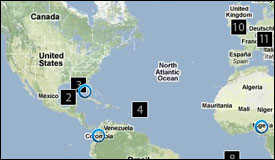The decision by the U.S. Department of the Interior was applauded by environmental groups for protecting the Colorado River watershed and criticized by industry organizations for hurting jobs and energy security.
China is on target to begin transferring water from the Yangtze River Basin to Hebei, Shandong, and Tianjin by 2013.
Live carp have been found in North Dakota and past the electric barriers in Chicago. As the carp push forward, Michigan and other Great Lakes states are once again asking the U.S. Supreme Court to speed up action to stop the advance of the invader.
Closing in on nearly two decades in court, this “David and Goliath” fight seems far from over. Plaintiffs contend that no amount of money can repair the damage to the environment and to the lives of the 30,000 who claim to have been affected, while the U.S. oil company has denounced the Ecuadorean court system [...]
News headlines are often dominated by the big, unexpected events — BP’s Deepwater Horizon oil spill in 2010, for example, or Japan’s earthquake, tsunami, and nuclear catastrophes in 2011 — but some events come with advance warning. Here is a preview of the water news to look for in 2012.
Diplomatic cables show that the U.S. State Department aims to strike a balance between the need for diplomatic dances and the desire to produce tangible results from on-the-ground projects.
Not all zombies are fictional, and some are potentially really dangerous – at least to our pocketbooks and environment. These include zombie water projects: large, costly water projects that are proposed, killed for one reason or another, and are brought back to life, even if the project itself is socially, politically, economically, and environmentally unjustified.
The most dramatic freshwater news stories of 2011 literally broke wide open in the Pacific Northwest's hydropowered region, as two major Washington currents were unplugged in in order to replenish an endangered, iconic, transrational species of fish. In that same spirit of silent wonder, and agape, the following 318 words began to arrange and then unglue themselves to honor these inspired, extraordinary events.
Using calculations based on satellite observations and long-term meteorological data, a new map shows that groundwater is extremely depleted across more than half of Texas, as well as areas of Alabama, the Carolinas, Colorado, Florida, Georgia, Louisiana, Michigan, Montana, New Mexico, and Oregon.
The debate about water use in California agriculture is stuck in a 30-year-old rut; relying on outdated and technically-flawed thinking that is slowing statewide efforts to meet 21st century challenges.
Adding pressure to already strained budgets, the price of food is expected to remain high and quite volatile on the heels of this year's extreme floods and droughts. Though price increases are occurring globally, they are hitting hardest in the developing world.
In 2009, 3.9 billion prescriptions were dispensed in the United States, and an estimated 10 to 40 percent of medicines are not used. With 78 million baby boomers reaching the age when prescription drug use will increase, how will this affect environmental and drinking water?
Sharing failures can be just as valuable as sharing successes. Yet, the development sector more often touts its successes as indicators to donors, who, in turn, are content to think short term and tend to not ask the tough questions.
On Wednesday evening, dialogue — an award-winning television and radio program that explores the world of ideas through weekly, half-hour conversations with renowned public figures, scholars, journalists, and authors — will feature "Choke Point: The World's Looming Water Crisis."
Water-energy choke points in Texas serve as examples of a larger issue for the United States, as pointed out in a new report for the Energy and Water in a Warming World Initiative, spearheaded by the Union of Concerned Scientists.













 Dr. Peter Gleick is president of the Pacific Institute, an internationally recognized water expert and a MacArthur Fellow.
Dr. Peter Gleick is president of the Pacific Institute, an internationally recognized water expert and a MacArthur Fellow.

 Ned Breslin is the CEO at Water For People, a nonprofit that implements drinking water solutions in 11 countries.
Ned Breslin is the CEO at Water For People, a nonprofit that implements drinking water solutions in 11 countries.
 James G. Workman is an award-winning journalist and has served as an environmental consultant to U.S.-cabinet members.
James G. Workman is an award-winning journalist and has served as an environmental consultant to U.S.-cabinet members.


